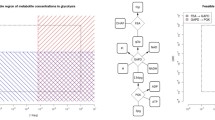Abstract
Elementary flux mode analysis is a promising approach for a pathway-oriented perspective of metabolic networks. However, in larger networks it is hampered by the combinatorial explosion of possible routes. In this work we give some estimations on the combinatorial complexity including theoretical upper bounds for the number of elementary flux modes in a network of a given size. In a case study, we computed the elementary modes in the central metabolism of Escherichia coli while utilizing four different substrates. Interestingly, although the number of modes occurring in this complex network can exceed half a million, it is still far below the upper bound. Hence, to a certain extent, pathway analysis of central catabolism is feasible to assess network properties such as flexibility and functionality.
Similar content being viewed by others
References
Edwards, J.S. and Palsson, B.O. The Escherichia coli MG1655 in silico metabolic genotype: its definition, characteristics, and capabilities. Proc. Natl. Acad. Sci. U.S.A. 97 (2000) 5528–5533.
Fell, D.A. and Wagner A. The small world of metabolism. Nat Biotechnol., 18 (2000) 1121–2.
Heinrich, R. and Schuster, S.: The Regulation of Cellular Systems. Chapman & Hall, New York, 1996.
Klamt, S., Schuster S. and Gilles E.D.: Calculability analysis in underdetermined metabolic networks illustrated by a model of the central metabolism in purple nonsulfur bacteria. Biotechnol. Bioeng. 77 (2002) 734–751.
Schilling, C.H., Schuster, S., Palsson, B.O. and Heinrich, R.: Metabolic pathway analysis: Basic concepts and scientific applications in the post-genomic era. Biotechnol. Prog. 15 (1999) 296–303.
Schuster, S., Dandekar, T. and Fell, D.A.: Detection of elementary flux modes in biochemical networks: A promising tool for pathway analysis and metabolic engineering. Trends Biotechnol. 17 (1999) 53–60.
Schuster, S., Fell, D. and Dandekar, T.: A general definition of metabolic pathways useful for systematic organization and analysis of complex metabolic networks. Nature Biotechnol. 18 (2000) 326–332.
Schuster, S., Pfeiffer, T., Moldenhauer, F., Koch, I. and Dandekar, T.: Exploring the pathway structure of metabolism: decomposition into subnetworks and application to Mycoplasma pneumomniae. Bioinformatics, 18 (2002) 351–361.
Stelling, J., Klamt, S., Bettenbrock, K., Schuster, S. and Gilles, E.D.: Predicting key aspects of functionality and regulation from metabolic network structure. Submitted.
Stephanopoulos, G.N., Aristidou, A., Nielsen, J.: Metabolic Engineering. Academic Press, San Diego, 1998.
Author information
Authors and Affiliations
Rights and permissions
About this article
Cite this article
Klamt, S., Stelling, J. Combinatorial Complexity of Pathway Analysis in Metabolic Networks. Mol Biol Rep 29, 233–236 (2002). https://doi.org/10.1023/A:1020390132244
Issue Date:
DOI: https://doi.org/10.1023/A:1020390132244




